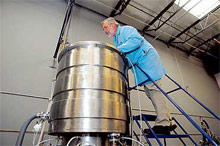QuantumSphere, Inc., a leading developer of advanced catalyst materials, electrode systems, and related technologies for portable power and clean-energy applications, has announced electrodes coated with the company's Nano NiFe(tm) catalysts to accelerate the production of clean hydrogen for industrial applications. 
Leveraging a proprietary advanced catalyst formulation, the Nano NiFe coated electrodes effectively increased the surface area of electrodes used in commercial electrolysis by approximately 1,000 times. This increase is due to the high surface area of the nickel and iron nano catalysts used to coat the electrodes. For example, one gram of Nano NiFe material has the surface area of about the size of a soccer field. These proprietary electrodes have demonstrated up to a threefold improvement in hydrogen output while maintaining energy efficiency, making it a commercially viable replacement for fossil fuel-based production methods.
To date, the Nano NiFe coated electrodes have surpassed 1,000-hour durability testing under harsh conditions (33% KOH, 1 A/cm2). These nano-enabled electrodes increase hydrogen gas output in electrolysis systems by 300%, at 85% efficiency, and pave the way for on-demand hydrogen needed for industrial and mass transportation applications.
"The QuantumSphere Nano NiFe electrodes are intended to accelerate the clean production of hydrogen through electrolysis and reduce industrial dependence on production methods that result in the net production of greenhouse gases," said Kevin Maloney, president and CEO, QuantumSphere, Inc. "Now with the use of our Nano NiFe coating, we are literally splitting the water more efficiently and turning heads in the scientific, industrial, and transportation communities. QuantumSphere's long-term commitment to enabling the clean-energy economy takes another step forward through the introduction of these low-cost electrodes."
Hydrogen has been identified as an alternative to petroleum. However, today's current large-scale hydrogen production techniques also produce inordinate amounts of greenhouse gases, such as carbon monoxide and carbon dioxide. The steam-reformation process, which accounts for roughly 90 percent of hydrogen production using natural gas, also produces four pounds of greenhouse gases for every one pound of hydrogen produced.
Before the use of QSI-Nano(r) catalysts, production of hydrogen through electrolysis had been hindered by high-cost catalysts and low efficiency. The formulation of Nano NiFe catalysts now makes it possible to produce hydrogen with an efficiency exceeding a key U.S. Department of Energy benchmark.
Hydrogen is in demand for several developing clean and renewable energy uses. Research now being conducted seeks to generate high rates of the gas via on-board electrolysis to fuel plug-in hybrid electric / hydrogen fuel cell vehicles and for stationary fuel cell back-up power systems.
"Efficient hydrogen fuel generation enabled by Nano NiFe electrodes unlocks the potential to simplify the hydrogen infrastructure and accelerate other renewable energy technologies while also providing a clean solution for industrial applications," said Kimberly McGrath, Ph.D., director of fuel cell research, QuantumSphere, Inc. "We envision the consumer being able to refuel their vehicles at home from garage electrolyzer units using water and off-peak electricity at night and solar power during the day."

